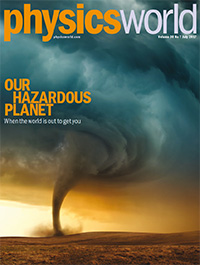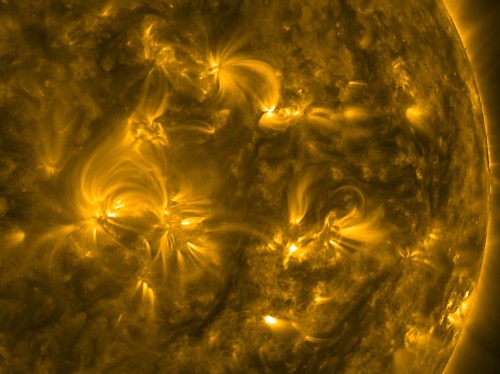Tag archives: Earth
Our hazardous planet: when the world is out to get you
 By Matin Durrani
By Matin Durrani
For people afflicted by last month’s devastating fire at Grenfell Tower in London or for those caught up in recent terrorist atrocities, it can seem that many problems in this world are entirely of our own making.
Yes the modern world has benefited from our collective wisdom and creativity – especially through science and engineering – but often it feels as if irrational human behaviour lies at the root of many of our troubles.
Nevertheless, we should remember that our planet itself holds many natural hazards too, as the latest special issue of Physics World reminds us.
Remember that if you’re a member of the Institute of Physics, you can read Physics World magazine every month via our digital apps for iOS, Android and Web browsers.
View all posts by this author | View this author's profile
Space weather: it’s all about impact
By Susan Curtis

Dangerous affair – an extreme ultraviolet image of a tangle of arched magnetic filed lines in the Sun’s corona, taken in January 2016 by NASA’s Solar Dynamics Observatory. (Courtesy: Solar Dynamics Observatory, NASA)
We all love a good disaster movie, but when it comes to real life it’s all too easy to downplay a dangerous but distant threat. Many people choose to live on active volcanoes, the citizens of San Francisco know that “the Big One” could strike at any moment, and yet they believe that the benefits of living in those locations outweigh the risk of a severe event happening in their lifetime.
The same dilemma faces the community of scientists, engineers and policy-makers who are working to understand the impacts of space weather – changes in the Earth’s environment that are largely are driven by physical processes originating from the Sun. Space weather has the potential to disrupt or even damage critical infrastructures on Earth, such as the power grids, aviation routes and communication systems that modern societies depend on, but the last notable event dates back to 2003.
That’s why Mike Hapgood, who heads up the Space Weather Group at RAL Space, part of the UK’s Rutherford Appleton Laboratory, has written a new, free-to-read Physics World Discovery ebook called Space Weather. “I thought it would be a great opportunity to highlight what space weather is really about, and to show how we are linking our scientific knowledge to a better understanding of the impacts on society,” he comments.
View all posts by this author | View this author's profile
Earth’s silent hitchhiker seen at last

This artist’s concept illustrates the first known Earth Trojan asteroid (Credit: Paul Wiegert, University of Western Ontario, Canada)
By Tushna Commissarat
Looks as if the Earth has a cohort – one that has been hitching a ride with our planet’s orbit for a while now. Astronomers sifting through data from NASA’s Wide-field Infrared Survey Explorer (WISE) mission have discovered the first known “Trojan” asteroid orbiting the Sun along with the Earth. It has been known since 1772 that stable small bodies can share the same orbit with a planet or a moon – as long as they remain at stable points in front of or behind the main body. Such Trojan asteroids have been found orbiting Jupiter, Mars, two of Saturn’s moons and Neptune, but had not been seen for the Earth until now. This is because they are difficult to detect, being relatively small and appearing near the Sun from the Earth’s point of view.
Trojans circle around “Lagrange points” – gravity wells where small objects can be relatively stable compared with two larger objects, in this case the Sun and the Earth. The points that the Earth’s Trojan – called 2010 TK7 – orbits around are known as the L4 and L5 points, and are 60° in front of and behind the Earth, respectively. As they constantly lead or follow in the same orbit as the planet, they can never collide with it; so you can breathe a sigh of relief if you were worried about a possible armageddon.
“These asteroids dwell mostly in the daylight, making them very hard to see,” says Martin Connors of Athabasca University, Canada, lead author of a paper about the discovery published in Nature. “But we finally found one, because the object has an unusual orbit that takes it farther away from the Sun than is typical for Trojans. WISE was a game-changer, giving us a point of view difficult to have at the Earth’s surface.”
The WISE telescope scanned the entire sky in the infrared from January 2010 to February this year. The researchers began looking for data for an Earth-bound Trojan using data from NEOWISE – a WISE mission that focused in part on near-Earth objects (NEOs), such as asteroids and comets. NEOs are bodies that pass within 45 million kilometres of Earth’s path around the Sun. The NEOWISE project observed more than 155,000 asteroids in the main belt between Mars and Jupiter, and more than 500 NEOs, discovering 132 that were previously unknown. The team found two Trojan candidates – of these, 2010 TK7 was confirmed as an Earth Trojan after follow-up observations were made using the Canada–France–Hawaii Telescope in Hawaii.
2010 TK7 is roughly 300 metres in diameter, at a distance of about 80 million kilometres from Earth. It has an unusual orbit that traces a complex motion near the Lagrange points in the plane of the Earth’s orbit, although it also moves above and below the plane. The asteroid’s orbit is well defined and remains stable for at least 10,000 years. For the next 100 years, it will not come closer to the Earth than 24 million kilometres (by angela). An animation, with a Star Wars worthy soundtrack, showing the orbit can be found below. (Image and video credit: Paul Wiegert, University of Western Ontario, Canada.)
A handful of other asteroids also have orbits similar to Earth. Such objects could make excellent candidates for future robotic or human exploration. Unfortunately, asteroid 2010 TK7 has not been deemed worthy of exploration because it travels too far above and below the plane of Earth’s orbit, and so would require a large amount of fuel to reach it.
View all posts by this author | View this author's profile
Hubble – one million and going strong
By Tushna Commissariat
I have already raved on about the awesomeness of the Hubble Space Telescope in my blog entry about its 21st anniversary in April this year. Now, the telescope has crossed yet another milestone – on Monday 4 July the Earth-orbiting observatory logged its one-millionth science observation! The image above is a composite of all the various celestial objects ranging through stars, clusters, galaxies, nebulae, planets, etc that Hubble has catalogued over the years. Click on the image for a hi-res version. [Credit: NASA, ESA and R Thompson (CSC/STScI)]
The telescope has had a significant impact on all fields of science from planetary science to cosmology and has provided generations with breathtaking images of our universe ever since it was launched on 24 April 1990 aboard Discovery’s STS-31 mission.
Hubble’s counter reading includes every observation of astronomical targets since its launch. The millionth observation made by Hubble was during a search for water in the atmosphere of an exoplanet almost 1000 light-years away from us. The telescope had trained its Wide Field Camera 3, a visible and infrared light imager with an on-board spectrometer on the planet HAT-P-7b, a gas giant planet larger than Jupiter orbiting a star hotter than our Sun. HAT-P-7b has also been studied by NASA’s Kepler telescope after it was discovered by ground-based observations. Hubble now is being used to analyse the chemical composition of the planet’s atmosphere.
“For 21 years Hubble has been the premier space-science observatory, astounding us with deeply beautiful imagery and enabling ground-breaking science across a wide spectrum of astronomical disciplines,” said NASA administrator Charles Bolden. He piloted the space shuttle mission that carried Hubble to orbit. “The fact that Hubble met this milestone while studying a far away planet is a remarkable reminder of its strength and legacy.”
Hubble has now collected more than 50 terabytes – the archive of that data is available to scientists and the public at http://hla.stsci.edu/
And take a look at this Physics World article by astrophysicist Mark Voit where he looks at the most iconic images Hubble has produced over the years – Hubble’s greatest hits
The NASA video below was created last year for the 20th Hubble anniversary celebration and tells you how you could send a message to Hubble that will be stored in its archive.
View all posts by this author | View this author's profile
